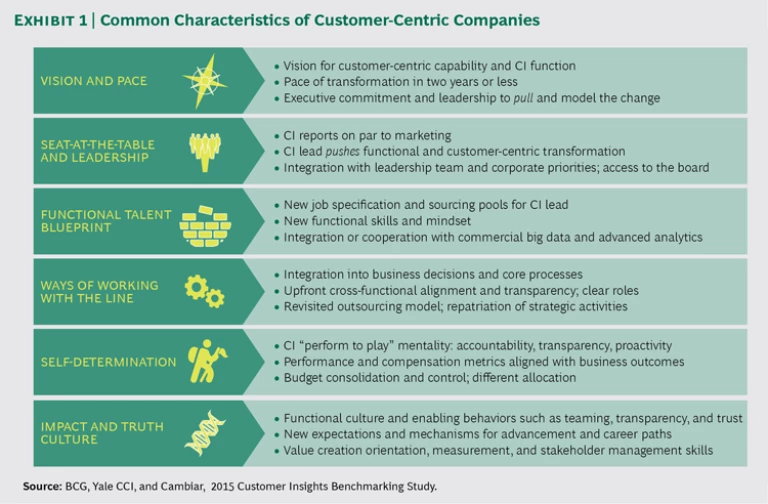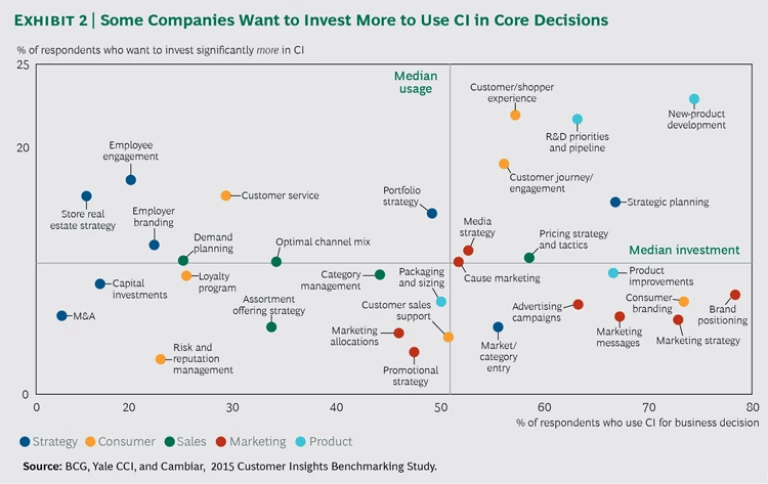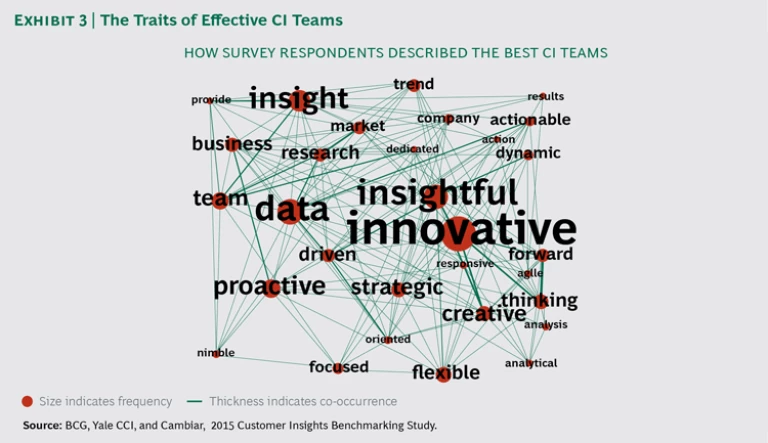This is the third article in a series exploring CI functions in consumer-facing industries. Upcoming articles will explore the engagement model with business line partners and alignment and collaboration mechanisms such as ROI, strategic and operational planning, budget allocation, and performance culture.
Why is it so rare for customer insight (CI) functions to have a seat at the table when key decisions are being made? Executives in consumer-facing companies know that understanding customers’ motivations and anticipating their behavior can accelerate and amplify growth. Yet most organizations struggle to integrate CI into their strategic decision making and core processes.
The Customer Insight Series
CEOs and CI practitioners we’ve surveyed point to various factors that they believe inhibit the elevation of CI within an organization . One of the biggest is tight budgets and a culture of cost containment. In the low-growth environment that has prevailed in consumer industries since the global recession of 2008 and 2009, many senior executives are unwilling to continue investing in a function whose return on investment is not measured.
But in our examination of companies that have managed to turn their CI functions into a source of strategic insight and competitive advantage, we’ve found that budgets aren’t necessarily a determining factor. Elevating CI to a strategic position is not necessarily about spending more; it’s about spending smarter. That involves giving CI control over existing spending and letting CI professionals set priorities. It also involves getting the right profile to lead the function and, just as important, staffing CI teams with the right kind of new talent.
Identifying the Barriers to Maturity
To gain an understanding of companies’ attitudes toward CI and what it takes to develop a strong CI capability, The Boston Consulting Group’s Center for Customer Insight, in partnership with Cambiar and the Yale School of Management’s Center for Customer Insights, conducted a benchmarking study in 2015 to update and expand BCG’s seminal study. (See The Consumer’s Voice—Can Your Company Hear It? BCG report, November 2009.) The new study included almost 650 respondents from more than 90 customer-facing enterprises across all sectors of the consumer industry.
More than 60% of participant companies reported annual revenue of $5 billion or more, and about 70% operate globally. Respondents were balanced among senior executives, insights and analytics practitioners, and senior business line partners. They also were evenly split between corporate and business unit (BU) positions.
The benchmarking examined companies with CI functions to pinpoint the most important behaviors and characteristics, across six criteria, common to leading customer-centric, externally focused organizations. (See Exhibit 1.)
In addition, BCG in 2016 surveyed 45 cross-sector CEOs, presidents, and chief operating officers (COOs) in companies with internal CI functions. While budget tops CEOs’ list of barriers to the advancement of CI, senior executives also cited concerns such as culture, integrating CI into the executive agenda, and the lack of a strategic orientation among CI practitioners. Some senior executives saw data and analytics capabilities—a recent focus in many companies—as competing with CI for budget, head count, and leadership attention. Others saw those capabilities as unintegrated and uncoordinated with CI advancement. All respondents, however, strongly agreed that CI’s unproven ROI is a significant barrier, a topic we will address in a future article.
Our research in 2009 revealed that CI functions generally move through four stages of maturity—a pattern that is still relevant today. (For more on these stages, see the second article in this series, “ Why Companies Can’t Turn Customer Insights into Growth ,” August 2016.)
- Stage 1: Traditional market research provider
- Stage 2: Business contributor
- Stage 3: Strategic insight partner
- Stage 4: Source of competitive advantage
In our 2015 benchmarking study, we found that only 20% of companies have CI functions that are at stages 3 and 4. Some of the obstacles our survey respondents cited indeed help explain why the higher levels of CI maturity are so rare, but the experience of companies that have reached those levels sheds light on what’s most important for building an effective CI capability.
The Red Herring of Budget and Head Count
Both CI practitioners and CEOs focus on budgets as a key barrier to the success of the CI function. Yet CI budgets appear to be rising, particularly outside the consumer packaged goods (CPG) sector, and it is not clear that spending above a certain threshold translates to success.
Among all the companies we studied, those at stage 1 have below-average budgets and team sizes. Beyond minimally sufficient resources, however, companies at higher levels of CI maturity do not necessarily have larger budgets. Generally speaking, it is more important how and on what companies spend their CI budgets than how much they spend.
Consider the CPG industry. Although CI budgets as a percentage of revenue have fallen for CPG companies since 2009, they are still almost three times as large in CPG as they are in the retail, restaurant, and non-CPG consumer sectors. Compared with the fashion and apparel sectors, budgets for CI within CPG companies are 50% higher. However, the CPG industry’s CI maturity is only slightly higher than that of other consumer-facing industries. This is likely because the industry allocates almost half of every CI dollar to tactical, backward-looking, and descriptive efforts involving existing products in existing channels and markets. This is the second-highest rate among the sectors we examined.
Budgets alone do not determine CI effectiveness. Nor does the size of the CI team, although average team sizes appear to be rising. Among the companies we studied, teams range from fewer than ten to more than several hundred full-time equivalents (FTEs). CPG leads consumer-facing sectors in CI group size, with several sectors significantly below the average. Overall, the median size of CI groups has risen from 14 in 2008 to 16 in 2015. Stage 2 companies’ median group size, for example, is 19. While it depends greatly on company size, sector, and business model, a minimally sufficient CI team size typically exceeds 7 to 9 FTEs (higher if integrated with data and analytics). For companies that are past stage 1 in the maturity of their CI function, we have found no strong correlation between team size and maturity level.
Instead of wrangling for bigger budgets and building empires, CI leadership should instead attempt to bring a larger share of CI expenditures under the function’s control. CI functions typically control 60% of the total CI budget; spending outside of CI control can fluctuate from about 30% for retailers and restaurants to about 45% for CPG companies. As one senior CI practitioner in CPG said, “We are aiming for 100% budget control. We want to have visibility into the total spend.”
Moreover, although most companies, especially in CPG, integrate commercial big data and customer analytics groups into their CI functions, retailers, restaurants, and other non-CPG consumer companies keep these groups separate because they grew up separately. Distributing CI-related spending across the organization renders CI leadership less able to allocate budgets appropriately, measure ROIs comprehensively and consistently, and establish priorities on resources. In addition, it disperses accountability, inhibiting the company’s ability to manage CI leadership performance and tie variable compensation to business performance.
Integrating CI into Business Decisions and Core Processes
Despite executives’ awareness of the importance of gathering and acting on information about customers’ needs and wants, our research reveals that companies use CI in less than half of 30-plus business decisions and core processes. CPG and consumer durables companies led all sectors, integrating CI into 56% of their core processes; the automotive and retail industries lagged behind. Stage 1 companies integrate CI into only about 30% of core decisions, but maturity increases usage to as much as 75% for stage 4 companies.
In all the consumer-facing industries we examined, respondents said they are most likely to apply an understanding of customer insights to positioning and branding efforts. The CPG, restaurant, and non-CPG consumer sectors said they were also likely to use CI in new-product development.
There have been some bright spots since 2009. The integration of CI in decisions regarding pricing and promotional strategy has increased from 38% to 60%, and 37% to 47%, respectively.
But most businesses have not tapped CI’s potential in other areas. Business models and functions with less direct or immediate consumer exposure—such as IT, corporate development, risk management, legal, and human resources—are less likely to incorporate CI into decisions such as capital investment, mergers and acquisitions, or risk and reputation management. More surprising, CI approaches and methodologies are not widely used in employer branding, employee engagement, and customer loyalty programs.
Many companies surveyed said they would spend even more on CI integration in areas such as new-product development, R&D, customer experience, customer engagement, strategic planning, and employee engagement. (See Exhibit 2.)
The New Job Spec for CI Leaders and Practitioners
We have argued in a previous article that the path to stages 3 and 4 of CI maturity must be pulled by the CEO and senior executives rather than pushed by CI practitioners. Transforming CI functions indeed requires an activist CEO or leadership team, but a visionary, persistent, and effective CI leader and strong CI team members are also crucial.
Our survey respondents described the best CI leads as “data-driven,” “analytic,” “visionary,” “insightful,” “flexible,” “creative,” and “strategic,” with a good understanding of the business. Notably absent were the words “specialist” and “technical expert.” One head of strategy and insight at a CPG company explained, “I need a commercial thinker more than a technical expert. I can buy technical expertise from suppliers.” In terms of a CI head’s leadership and engagement style, respondents valued “openness,” “dynamism,” and “good listening skills.”
We asked executives in stage 4 companies, in which CI is a source of competitive advantage, how the CI capability in their organizations had to change in the past in order to close gaps between actual and desired performance. They focused on developing more strategic thinking among CI leaders and improving coordination on three-year strategic plans, annual operating priorities, initiatives, and budgets. Stage 4 executives expect their CI group to have proprietary perspectives and learning agendas that are originated by the function and not by business line partners on priority topics, consumer cohorts, and innovative research methods. In the words of one retailer’s chief marketing officer: “There’s an insatiable curiosity, which I think is absolutely vital for this role—curiosity about the technology, changes to the industry, and trends—and not just about consumer trends but also ways we can do things better.”
While stage 4 companies focused on the desirable traits in a CI leader, companies at lower maturity levels were more concerned about CI practitioners below the leader, citing the need for more strategic thinking and a deeper understanding of the company’s economics among CI staff. CPG companies wanted key executive team members with CI backgrounds and routine updates on the function’s performance and budget compared with its plan.
Overall, our respondents wanted their CI teams to have many of the same characteristics as CI leaders; they used words like “innovative,” “insightful,” “data-driven,” “forward-thinking,” and “creative.” Respondents also wanted team members who are “strategic,” “proactive,” “flexible,” “nimble,” “agile,” and “responsive,” and a CI capability that has “dynamic” insights into trends with “actionable” recommendations that drive business results such as accelerated growth, disproportionate share gain, improved loyalty, and a sustained price premium. (See Exhibit 3.) According to one CPG president: “You need a diverse team with all those skills that can bring all the insights together and integrate them into one source of truth of consumer needs, wants, and desires.”
Access to and Development of Talent
Senior executives may know what they’re looking for in CI leaders and practitioners, but finding individuals with those qualities and skills, or developing that kind of talent, is a challenge. Among the barriers to improving CI capabilities our respondents cited was access to talent with new skills and mindsets, familiarity with the business, a strategic perspective, and a grounding in economics. According to the president of global retail at a consumer products company, the problem is that hiring is off-target: “We have embraced CI as important but have staffed it with the wrong people from marketing.”
On a positive note, companies appear to be creating clearer paths and more training. The proportion of companies at which CI practitioners said moving into more senior roles was easier grew by 20 percentage points from 2009 to 2015. Meanwhile, the number of companies that had a rotational program for CI employees increased by 28 points. “Because we encourage the rotation of people, including to the business side, finding talent is not that big an issue for us,” said an automotive sales executive. “A lot of our research people rotate into business units so that they can use that knowledge in their new functions.” Since 2009, the proportion of CI practitioners who have received training in the past six months increased by 12 points.
Not surprisingly, the maturity of the CI function is an important factor. Companies at stage 3 or 4—in which CI has regular access to the board and has a leader who is either an executive committee member or an advisor with routine access to executives—are much more likely to train CI leaders, include CI practitioners in company leadership programs, and rotate other employees onto CI teams.
The Call for a Strategic Point of View
In our 2015 study, 50% of business line partners said that they viewed CI team members as strategists and thought leaders, up 10 percentage points from 2009. A consumer durables marketing executive said, “One of the challenges is changing the perception of what role customer insight should play and showing that there is a seat at the table for the group within the organization—that we are partners in the performance of the business.”
The companies we studied described a strategic point of view as essential for a CI function. Functions that lack this strategic viewpoint may develop customer advocacy initiatives that are off-strategy, economically infeasible, or not an investment priority. CEOs and senior executives said they want insights that translate into recommendations relevant for the company’s strategy, positioning, performance, economics, and capabilities. They want their CI team to demonstrate a multistakeholder perspective beyond customer advocacy. And they want a CI team that can influence the organization through projects and, ultimately, ongoing decision-making support.
Many CI functions are not prepared for that role. As one executive told us, “CI recommendations now require two bounces. The first bounce is what consumers say they want, passed through from CI unfiltered. The second is what is on-strategy—where and how we can make money, and what we can afford. I’m looking for business recommendations from CI that integrate from the outset consumer, strategic, and economic viewpoints into one with a good dose of business judgment.”
To improve their strategic capabilities, CI organizations are experimenting with new roles, including a head of technology or data, information scientists, and storytellers. Some of our respondents see a tension between a strategic mindset and data and quantitative skills and experiences. A retail company CMO told us, “A barrier to innovation is the ability to recruit talent that can work across what would be traditional insights versus newer or data-driven insights. I get a lot of sharp folks who can garner insights out of data but can’t see the forest for the trees or don’t have the requisite influencing skills.” Another retail CMO added, “The war for talent is really for somebody who is fluent in the technology and is able to simplify and communicate that in a compelling manner.”
What to Do
Moving a company to the next level of maturity requires a mindset focused on the relationship between CI and the business and on the qualities of the people who will bring the function to life. The following moves can help companies achieve that mindset.
Understand that less is more. In general, CI leaders are better served when they focus on effectiveness and their function’s reputation rather than on budget- and empire-building. The use of CI in business decisions and core processes should start with understanding where, why, and how the company and its competitors use CI to make decisions, as well as how stage 4 companies invest in CI, data, and analytics. Companies should also know which decisions and core processes their executives, business line partners, and CI leadership see as investment priorities and align head count and budgets accordingly.
As part of the strategic-planning process, the CI leader should inform executive teams and business line partners of the decisions and core processes that are not currently supported by CI. In many cases, CI leaders may be able to fund the support of new areas by reallocating low-value research, data, tools, and reports rather than increasing budgets. In these discussions, CI leaders should set priorities for the function’s operating model that determine the role and scope of the internal team as well as the data sets and self-service and visualization tools provided to the organization.
Put diverse sets of eyes on every problem. Companies should examine how they develop CI leadership, access new talent, and embrace new ways of thinking. They should reevaluate how far the CI leader is removed from the CEO or president as well as the CI reporting structure. Companies may need to rewrite job specifications and redefine the roles and responsibilities of the CI leader. The description should shift from a specialized, technical expert to a trusted advisor who is data-driven, objective, adaptable, questioning, and insatiably curious. The ideal candidate should also be a strategic thinker who is familiar with the business and its economics. Companies should focus on the individual’s leadership style, influence and effectiveness, performance orientation, and executive behaviors.
Instead of hiring someone from direct competitors, forward-looking companies turn to sectors such as consumer financial services, digital businesses, marketing services, or media and media tech. In addition, these companies look at alternative talent pools with stronger business backgrounds such as strategic management consultants and financial and industry analysts.
In changing where they look for talent, companies must also market CI roles differently. In many cases, this means elevating functional reporting, offering a seat on the leadership team, integrating data and analytics into the function, or changing functional leadership. Some external marketing moves—such as the renaming of a CI function, a title change, or the use of a proven external recruiter in CI, analytics, marketing or strategy—may be easier to achieve.
Focus on CI development and career potential. While career training for CI practitioners is much better now than it was in 2009, companies still must improve CI leadership training, rotational programs, and career development both into and out of CI. Forward-looking companies identify and support CI leaders through training in advanced analytics, behavioral economics, social media monitoring, and visual storytelling, among other disciplines. “Strategy academies” for CI leads can detail how the company makes money, how stakeholder relationships are developed, how supplier negotiations are conducted, how change is managed, and how ROI is measured. To deliver programming and help defer training costs, companies should collaborate with supplier partners, academics, and peers in noncompeting sectors.
Revisit structure. To improve CI performance, companies should strengthen the CI team’s relationship with executive leadership by having it report more directly to the CEO. In addition to regular interactions with top executives, CI leaders should develop a learning agenda with executives and board members that covers topics such as megatrends, the habits of millennials and other consumer cohorts, new data sources, methodological innovations such as behavioral economics testing, and popular topics such as subconscious bias.
In their CI team structure, CI leads should adhere to best organization design practices. They should have minimally sufficient spans of control for themselves and managers, typically five to seven; roles should be balanced across traditional insights, advanced and customer analytics and testing, as well as across managers and specialized “player-coaches” such as data scientists. Typical individual contributors should not be above certain titles (such as director) or layers (such as three reporting layers from the CEO), acknowledging critical specialized roles in CI (such as data scientist or statistician). Typically, specialized roles should be consolidated, centralized, and shared for benefits of scale and, as important, for talent acquisition and development. In addition, companies should look to complement and support their talent needs through an advisory panel or academic and other third-party partnerships.
Strengthening a company’s CI capability requires resources, but what’s more important than the dollar amount is how those dollars are directed. By spending smarter, attracting the right kinds of new skills and mindsets, and letting CI professionals set priorities, companies are on their way to turning CI functions into a source of strategic insight and competitive advantage.











